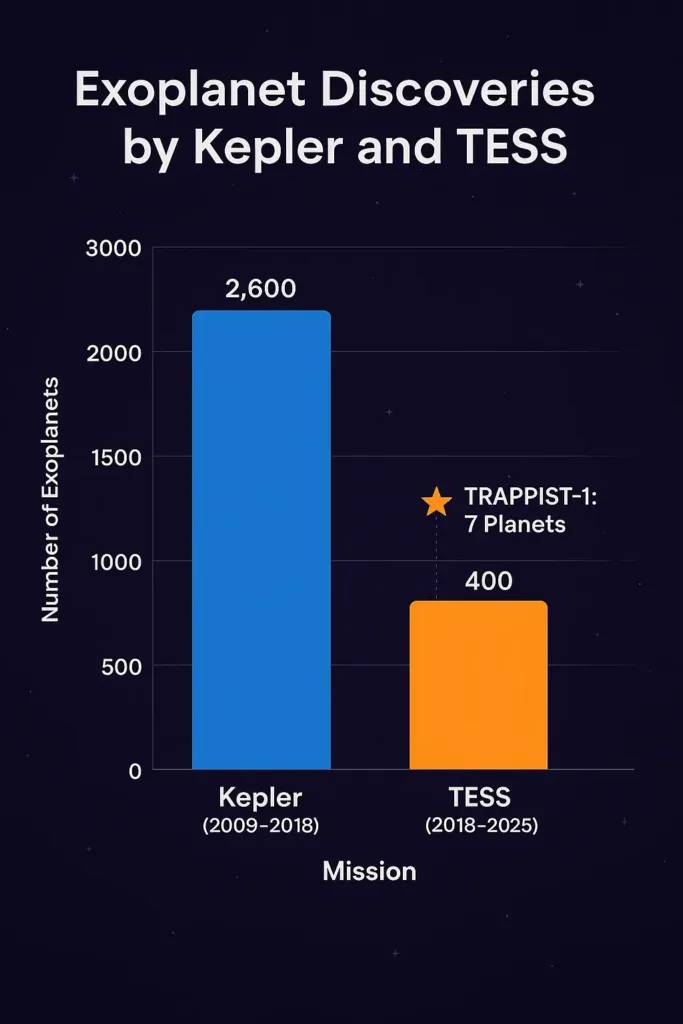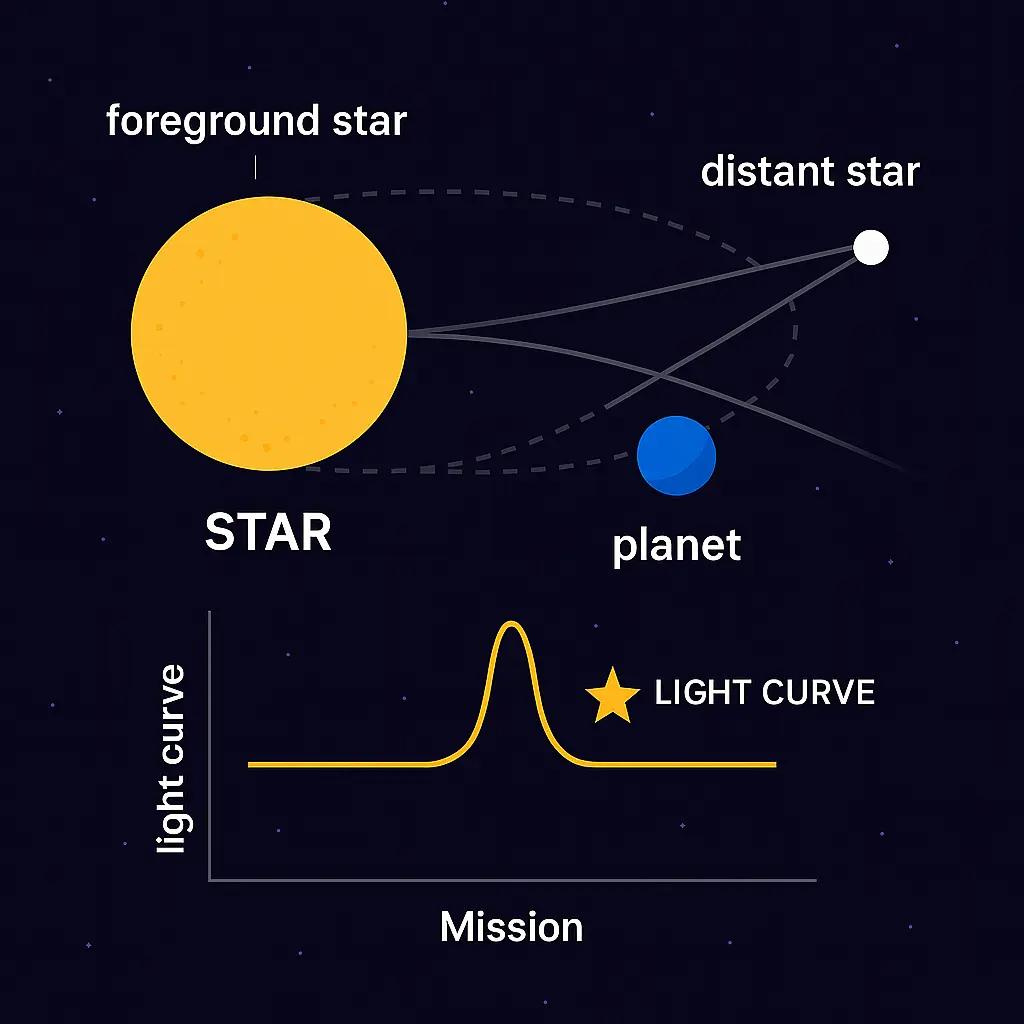Imagine a universe full of planets circling stars far, far away, some of which might even have life. It looks like a sci-fi movie. Well, it is actually happening. As of July 2025, we have officially confirmed over 5,000 exoplanets! Each find shows just how clever we humans can be. But here is the big question: how do we actually find these exoplanets? They are out there, hiding from our naked eyes. We have some very smart techniques to spot them. We can find them either indirectly or, on rare occasions, directly.
It all started in 1995 with the discovery of 51 Pegasi b. It was the first exoplanet found orbiting a star like our Sun. That discovery significantly changed the game for astronomers everywhere. So, why should we care about finding exoplanets? It helps us figure out where we fit in this vast universe. We also watch how planets form and look for places that might support life.

In this article, we dive into five key methods to explain how to find exoplanets. This makes complex science accessible to everyone. These methods are Transit Photometry, Radial Velocity, Direct Imaging, Gravitational Microlensing, and Astrometry. Each of these techniques offers something unique. Some help in measuring how big a planet is. Others allow snapping a picture of it.
Method 1: Transit Photometry: A Key Technique for How to Find Exoplanets
Transit Photometry is a cornerstone of how to find exoplanets, detecting planets by observing their transits. In this approach, the stellar surfaces are monitored continuously, looking for minimal changes in their brightness.
How It Works — The Cosmic Shadow Play
A planetary transit occurs when a body passes in front of its parent star. It blocks some of the light incident on it. This creates a dimming effect. Experienced observers could quantify this effect. The stars lose their brightness by a measurable percent. To physicists, this is akin to when an insect blocks a flashlight, causing a negligible brightness loss. The comparable principle can be applied to exoplanets. A transit of a planet in an extrasolar system dims the flux of the star by a small value. This dimming is measurable by sensitive equipment. As the planet moves out, the transit ends. The stellar luminosity recovers its requisite brightness. The cycle repeats with each orbit.
Real-World Success Stories

The Kepler Space Telescope, which operated from 2009 to 2018, really changed the game for our understanding of the universe. It monitored over 150,000 stars. Believe it or not, it found thousands of exoplanets using this cool technique called the transit method. Then, in 2018, along came its successor, the Transiting Exoplanet Survey Satellite. This new telescope focuses on stars that are much closer to us. It aims to pinpoint planets that we can study in more detail.
One of the most exciting discoveries so far? The TRAPPIST-1 system. It’s about 40 light-years away and hosts seven planets that are roughly Earth-sized. What’s really intriguing is that three of those planets are in the so-called habitable zone. In this zone, liquid water might actually exist. Can you imagine what that could mean for the search for life beyond our own planet?
Limitations and Challenges
Transit photometry is a success-based technique. The orbit of a planet must be very accurately aligned to be detected by these techniques. Because only planetary orbital alignments that are edge-on to the earth will lead to transit, which is a rare occurrence. Also, there is the problem of false positives. Transit can be mimicked by eclipses of binary stars and stellar spots. Therefore, such detections are likely to require follow-up confirmation with spectroscopy to prove planetary status. Despite these shortcomings, transit photometry is considered to be a base method in the planet-searching process. It’s pretty mind-blowing!
Method 2: Radial Velocity: Wobbling Stars Reveal How to Find Exoplanets
The radial-velocity technique uses various spectroscopic systems. These systems recognize exoplanets by observing the wobbling of stars. This wobbling is caused by traveling partners. It has been the first to find extrasolar planets that orbit Sun-like stars.
Discovering the Gravitational Dance

Planetary orbits do not have to be circumstellar, but planet-star systems execute a mutual orbit performance of the stars. The common center of the two bodies defines the plane of reference in which the two bodies orbit. A relatively nearby planet will, in such an arrangement, cause the stellar parent to oscillate. This oscillation gives a noticeable wobble to the motion.
The star motion involves a periodic variation of the star velocity towards and away. This motion maintains a pattern that introduces a perceptible Doppler shift. The shift in the stellar features can be seen with the earth-based telescopes. The stellar blueward reemission is bluer. The redward migration is red in this case. On the other hand, the photospheric emission gains a redward shift as the star moves outward.
This explainable phenomenon is similar to the changes in pitch. These changes can be heard when an ambulance is coming towards you and later moving away. Starlight Doppler, consequently, gives a diagnostic sign of planetary influence and makes planetary orbital periods and minimal mass determinations possible.
Detection in Action
Astronomers Michel Mayor and Didier Queloz used the radial velocity method. They announced the discovery of 51 Pegasi b on 6 October 1995. It is a “hot Jupiter” orbiting around a star. Michel Mayor and Didier Queloz made the announcement on 6 October 1995. They used the radial velocity method to discover 51 Pegasi b. It is a hot Jupiter in a 4.2-day orbit around a Sun-like star. They released their findings in the journal Nature. This was the first hard evidence that exoplanets are indeed available. Consequently, they became the 2019 Nobel laureates in physics. Hundreds of other exoplanets have been discovered since the first discovery. The largest of these are on short-period orbits, found using the radial velocity method.
Advantages and Limitations
Advantages:
- Precise planetary mass measurements
- Effective for non-transiting planets
- Works on bright, nearby stars
Limitations:
- Bias toward massive, close planets—small, distant worlds produce weaker wobbles.
- Spectral noise from stellar activity can mask signals.
- Requires long-term monitoring for planets with long orbital periods.
Radial velocity spectroscopy is normally used with complementary detection methods. This approach helps achieve a holistic characterization of an exoplanet’s properties. It also aids in understanding the structure of the host system.
Method 3: Direct Imaging
Direct imaging is the most concrete embodiment of the characterization of exoplanets: optical resolution and measured exoplanetary photons. Even though the technical hurdles may be formidable and make routine success difficult, the process produces unique and planet-specific information.
The Ultimate Challenge
Direct imaging is the process of taking real pictures of exoplanets. That scenario would be similar to noticing a firefly next to a searchlight at a distance of a thousand miles. The stars are about billions of times brighter than the accompanying planets; consequently, the task becomes extremely challenging. To alleviate the issue, astronomers use coronagraphs to reduce the evanescent stellar photon flux. They utilize adaptive optics to overcome the atmospheric turbulence. There are other methods as well to find how to find exoplanets. These techniques then lighten the obscure planetary bodies.
Technological Breakthroughs
Direct imaging is particularly effective for observing young, hefty planets. These planets light up in infrared because of the heat they still keep from their formation. Remember back in 2008? The Keck Observatory managed to capture images of four planets circling the star HR 8799. And get this — each of those planets is about six to seven times the mass of Jupiter! They are hanging out quite far from their star. The infrared images they captured? They really show just how effective coronagraphy and adaptive optics systems can be.
Method 4: Gravitational Microlensing
Gravitational microlensing uses the theory of general relativity developed by Einstein to find extrasolar planets. A compact lensing star can be used to expose exoplanets that are otherwise obscured. This method opposes conventional exoplanet hunts by focusing mass.
The Physics Behind the Method of How We Find Exoplanets

Einstein had this amazing insight about how massive objects can actually warp spacetime. It is like they create these gravitational lenses. Picture this: when a star with a planet moves directly in front of a more distant star, it acts like a magnifying glass. The gravity from that foreground star pulls in the light from the background star. This makes it look way brighter than it normally would.
Now, if that foreground star happens to have a planet, things get even more interesting. That planet adds another layer of lensing, which shows up as a little spike in the brightness curve. And guess what? The details of that spike can tell us a lot about the planet. For instance, how massive it is. It also shows how far it is from its star.
But here is the catch: for this lensing effect to work, everything has to be perfectly lined up. Those two stars and Earth must all be in just the right spot. And let me tell you, these alignments are pretty rare and can be quite unpredictable. Each microlensing event is totally one-of-a-kind; you can not just repeat it.
Unique Advantages
Microlensing is a unique observation strategy to explore exoplanets at large distances. It helps discover ones that are low in mass, such as Earth-sized bodies found in habitable zones. A 2012 survey using microlensing methods estimated at least 100 billion planets in the Milky Way. Most were found by this method. It is specifically useful in the search for planetary companions to faint host stars. It also aids in finding companions to otherwise resolved host stars. This makes it complementary to more traditional techniques.
Challenges and Future
- Precise follow-up is challenging due to unpredictable timing.
- Host star often too faint to characterize directly.
- Microlensing events are one-time occurrences—no repeat observations.
The Nancy Grace Roman Space Telescope is launching in 2026. It should survey the sky in much broader swaths. It will do this at a shorter time interval than any other space observatory in history. This ability, merged with the significantly enhanced photometric accuracy, should raise the exoplanet detection rates. It will also allow the statistical analyses of populations of exoplanet systems throughout the galaxy.
Method 5: Astrometry
Astrometry is a method used in stellar characterization and in the identification of exoplanets. This method traces the precise locations of stars that planets circle. The perturbations on the stellar orbit given by the planets are small and periodic. They can be identified as familiar circular or elongated hair-like ellipses.
Precision Position Tracking
Astrometry is really fascinating. It involves pinpointing a star’s position with incredible accuracy. This is done to spot those little wobbles that happen when planets orbit around them. We are talking shifts so small they are measured in microarcseconds—like, super tiny! Observing from space is so beneficial. It helps avoid those pesky distortions from the Earth’s atmosphere. This technique complements other methods. It’s especially useful for finding planets that take their sweet time in orbiting their stars.
Current Status and Future of How We Find Exoplanets
Astrometry has not confirmed how to find exoplanets as some other methods have. Honestly, it holds a lot of promise. Gaia is continuously rolling out new data. We are expecting a treasure trove of discoveries. There may be hundreds of new planets, in fact! Many of these are likely long-period giants. We often miss these with transit and radial velocity surveys.
Looking ahead, there are some exciting missions on the horizon, like the proposed Theia, along with some advanced ground-based interferometers. They are prepared to enhance precision further. The focus is on Earth-sized planets in the habitable zones of nearby stars.
When you combine astrometry with data from radial velocity and transit methods, astronomers can determine an exoplanet’s orbit. They can calculate its true mass. They can even map its three-dimensional layout. This teamwork is crucial for mapping out our galactic neighborhood. It is also essential for figuring out how planetary systems form on a larger scale.
Comparing the Methods: Which Works Best When?
Each exoplanet detection method excels in specific scenarios, as shown in the table below:
| Method | Strengths | Weaknesses | Best For |
|---|---|---|---|
| Transit Photometry | Measures size, orbital period | Needs alignment, false positives | Close-in planets |
| Radial Velocity | Determines mass, orbit | Biased to massive, close planets | Massive, short-orbit planets |
| Direct Imaging | Images planets, studies atmospheres | Limited to young, massive planets | Young, distant planets |
| Gravitational Microlensing | Detects distant, low-mass planets | One-time events, no follow-up | Distant, Earth-mass planets |
| Astrometry | Sensitive to long-orbit planets | Requires high precision, few detections | Large-orbit planets |
These five methods show how to find exoplanets. They help us uncover a wide range of planetary systems. This includes everything from scorching hot Jupiters to worlds that are more like our Earth.
The Future of Exoplanet Discovery
The quest to understand how to find exoplanets is accelerating, with new technologies uncovering worlds like never before. Recent innovations have been a prime driver of this. The James Webb Space Telescope is already well underway in detailed characterization of exoplanet atmospheres. Future space- and ground-based missions hold the potential to further expand what can be observed.
Future telescopes will reveal the presence of Earth-like exoplanets. These exoplanets will lie inside habitable zones around the neighboring stars. This discovery will answer fundamental questions about life in the universe. Characterization of exoplanet atmospheres: Exoplanet atmospheres will be characterized using sophisticated analytical techniques and may include biosignatures.
The combined use of the five major detection techniques provides a holistic picture of the exoplanet populations. Individual methods provide a specific type of information. When combined, they offer a very detailed picture of how and why planets form and evolve. Collectively, these three are redefining knowledge of the solar planets.




